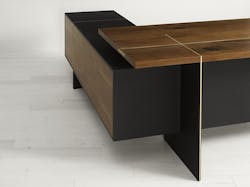Waste Not, Want Knot: Salvaging Trees with Urban Hardwoods
In the northwest neighborhoods of Seattle, Washington, hazardous and unhealthy trees are being given new life in the form of beautiful, hand-crafted furniture. Urban Hardwoods, an artisan-led furniture manufacturer, is leading a movement to make better use of its surrounding urban trees by custom crafting wood slab furniture from trees felled in Seattle neighborhoods. In fact, 90 percent of the materials used are sourced within a 20-mile radius of Seattle.
A USDA study estimates that nearly four billion usable board feet of material are culled from urban areas in the United States each year. Most of this material is considered part of the waste stream. These trees are in line to be turned to mulch, firewood or left to rot. Urban Hardwoods is working to change that – when trees require removal due to hazard or declining health, the company consults with tree services to salvage them and give them a second life as high-quality furniture like desks and tables.
Urban Hardwoods: One Tree at a Time
At Urban Hardwoods, the salvage, milling, drying, design and fabrication is all done one tree, one log, one table at a time. The company’s craftsmen are inspired by nature itself, with the color, figure and shape of each slab informing their designs. All the knots, unusual grain patterns and color variation – the "imperfections" that mainstream manufacturers cut away and discard – are the features that give each piece of Urban Hardwoods furniture its unique character.
Just like each piece of furniture has a unique story to tell, so do the craftsmen behind them. In our latest Maker Monday segment, Urban Hardwoods general manager Bryan Reed reveals how he got involved with the company and details behind his own creative process.
Quite the Opportunity
interiors+sources: How did you get your start?
Bryan Reed (general manager): I first encountered Urban Hardwoods while I was studying architecture. In the last quarter before graduation I was taking a furniture studio, and I asked Urban Hardwoods to help out a poor student by re-sawing a giant walnut slab. It turned into an opportunity to meet the owner and ultimately a job offer. I had another job offer from a design-build architecture firm, but I thought, “Let’s give this furniture thing a try. I can always go back to architecture.” I started at Urban Hardwoods three days after graduation … and that was over 13 years ago!i+s: What inspires you?
BR: I am very much inspired by architecture and nature and how they complement each other. I am also drawn to technical things like beautifully executed mechanisms and machines. Something about the movement and relationship of the components.
More than Slab Furniture
i+s: What is your most memorable product or collection you’ve worked on and why?
BR: My favorite collection is our Executive Collection because it was an opportunity to show that Urban Hardwoods isn’t just a “slab furniture” company. It shows off our capabilities and what is next for UH.
i+s: Describe what a typical workday for you looks like.
BR: I don’t have many typical days. We are a relatively small company and I have some involvement with all aspects of the company. I like the collaboration, and I enjoy the variety.
Creative Process Must-Haves
i+s: Name some must-haves you need or like to have on-hand when starting a new project.
BR: Whenever possible, a discovery meeting with the end user. Particularly with bigger projects or projects where we are developing custom or complicated pieces. So much vital information is communicated in that initial meeting that can’t always be captured in notes.
i+s: What challenges you most during your creative process?
BR: Finding and setting aside enough time, and then being vigilant about avoiding and ignoring distractions.
i+s: What is your favorite thing in your working environment?
BR: I like working at the shop, or more specifically the small office at our manufacturing facility. It is important for me to feel connected to that part of the process. The downside is a lot of distraction but the upside is great collaboration. I like working in a busy, active environment. I never liked working in a quiet library.
Design Favorites
i+s: What’s your favorite color?
BR: Since I don’t have a favorite color and black is a boring answer, I usually sidestep this question and answer, “What is my favorite wood/ finish?” To that, I answer my favorite dark wood is western walnut and my favorite light wood is American elm. Each has a beautiful range of colors that are interesting and complex.
i+s: What is your favorite design era?
BR: I know it is cliché, but modernism. I am always inspired by the balance between boldness and simplicity. It reminds me of the importance and power of editing.
i+s: Who has helped you realize your dreams?
BR: I had a gruff old-school architecture professor. In a program heavily focused on design theory, he delivered a lot of practical wisdom and advice that helped ground me, helped me plan my path and helped cultivate the courage to follow the plan.
You'll love I Hear Design: Salvaging DetroitThe Past & Future of Design
i+s: What do you think is next for the interior design industry?
BR: More discreet or hidden integration of technology with natural materials. Answering the client’s need for increased features and functionality without compromising the aesthetic. High tech, high touch.
BR: Do more, fear less. Designing is a “muscle” that you develop, the more reps the better. Explore, because the more you try, the broader your perspective will be. Don’t be afraid to put yourself out there. In my experience worrying about criticism was worse than receiving it.
i+s: What’s next for you?
BR: We are growing and are hiring more people, including a new designer. I look forward to working with her to launch several new products this year and working toward launching collections more frequently than we have in the past.
i+s: Where can people find your goods?
BR: Our website is www.urbanhardwoods.com and you can email inquiries to [email protected].
More content you'll love
Brand Renovations: A Tree Grows in Manhattan
Mid-Century Modern: Locally Made
Keeping Quiet: A Guide to Acoustics in Transportation Hubs
About the Author

Adrian Schley
Associate Editor
Adrian Schley was an Associate Editor for i+s, where she covered the commercial interior design industry since 2018. Her work can also be found in BUILDINGS and Meetings Today.




